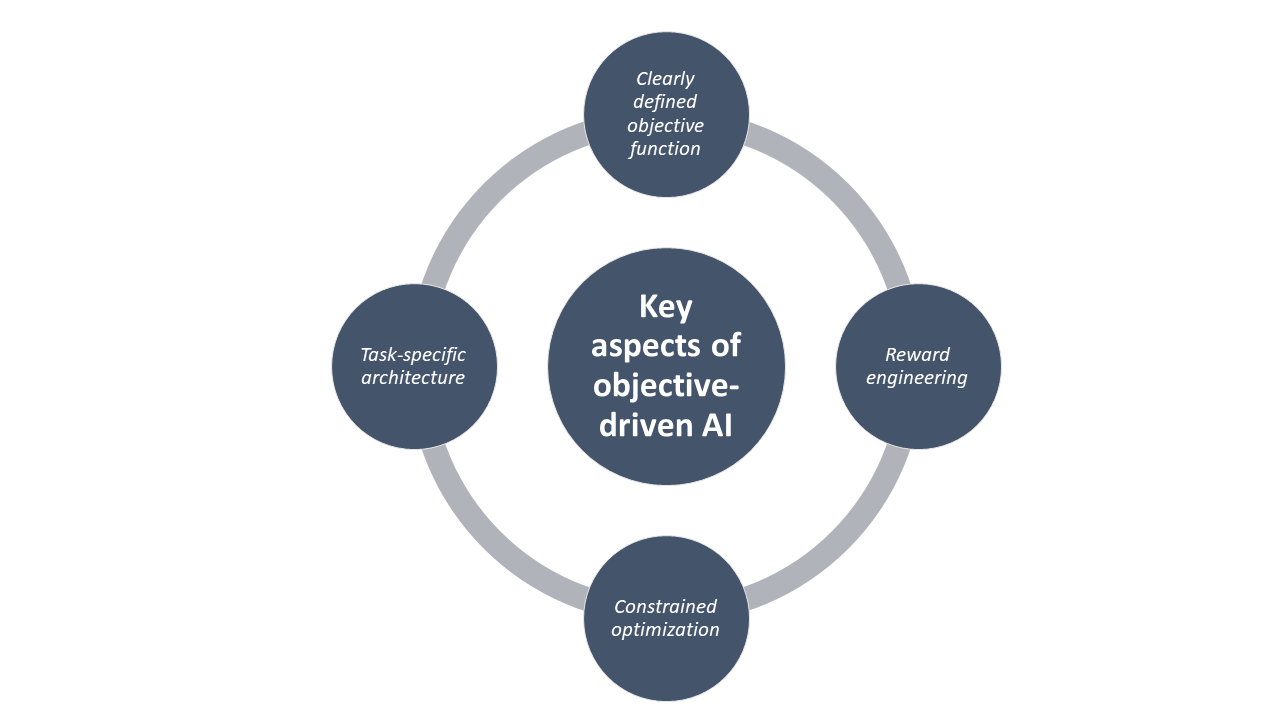
Objective-Driven AI: Optimizing Goals in a Complex World
A new paradigm has emerged that is transforming the way we approach AI system design and deployment.
This paradigm, known as objective-driven AI, represents a fundamental shift in how we conceptualize and develop intelligent systems. Rather than pursuing the elusive goal of general artificial intelligence (GAI) – the creation of systems that can match or exceed human capabilities across a broad range of tasks – objective-driven AI focuses on optimizing for specific, well-defined objectives.
The motivation behind this approach is both practical and strategic. As AI technologies have become increasingly sophisticated and ubiquitous, the demand for systems that can reliably and efficiently achieve particular goals has grown exponentially. From autonomous vehicles navigating complex urban environments to machine learning models predicting financial market trends, the need for AI that can consistently deliver on targeted outcomes has become paramount.
At the heart of objective-driven AI is the principle of constrained optimization. Unlike general-purpose AI systems that are trained to handle a wide variety of tasks, objective-driven AI models are designed and trained to optimize for a specific, measurable objective, subject to a set of constraints. These constraints may include safety considerations, ethical guidelines, performance requirements, or other real-world limitations.
By narrowing the focus of the AI system to a well-defined goal, objective-driven approaches can leverage specialized architectures, training algorithms, and reward engineering techniques to drive performance towards the desired outcome. This laser-like focus on optimization, coupled with the ability to incorporate contextual constraints, has the potential to yield AI systems that are more reliable, robust, and effective than their more generalized counterparts.
The Foundations of Objective-Driven AI
The foundations of objective-driven AI can be traced back to the early days of modern AI research, where pioneers in the field recognized the importance of defining clear objectives and optimizing towards them. One of the seminal works in this area was the development of reinforcement learning, a branch of machine learning that focuses on training agents to maximize a numerical reward signal through iterative interactions with an environment.
Reinforcement learning agents are designed to learn optimal policies – sequences of actions that maximize the cumulative reward received over time. This objective-driven approach has been instrumental in the development of AI systems that can excel at complex, sequential decision-making tasks, such as playing games like chess, or go.
Another influential concept in objective-driven AI is that of reward engineering, the process of carefully crafting the reward function to ensure that the AI system learns the desired behavior. By aligning the reward signal with the intended objective, reward engineering helps to shape the agent's learning process and guide it towards the optimal solution.
The importance of reward engineering cannot be overstated, as it directly addresses the challenge of value alignment – ensuring that the AI system's objectives are closely aligned with those of its human operators or stakeholders. Poorly designed reward functions can lead to unintended consequences, such as AI systems that exhibit exploitative or deceptive behavior in pursuit of their objectives.
In recent years, the principles of objective-driven AI have been applied to a wide range of domains, from robotics and autonomous systems to natural language processing and computer vision. As the complexity of these applications has grown, so too has the need for more sophisticated techniques to ensure the AI systems are optimizing for the right objectives while respecting relevant constraints.
Objective-driven AI refers to a paradigm in artificial intelligence where the AI system is designed and trained to optimize for a specific, well-defined objective or goal. This is in contrast to general-purpose AI systems that are trained to perform a wide variety of tasks without a specific end-objective in mind.

The key aspects of objective-driven AI include:
1. Clearly defined objective function: The objective that the AI system is trying to optimize is explicitly defined, quantified, and measurable. This could be things like minimizing a loss function, maximizing a score or reward, or achieving a particular outcome.
2. Reward engineering: The objective function is carefully crafted to ensure the AI system learns to exhibit the desired behavior. This involves designing appropriate reward signals that guide the system towards the intended goal.
3. Constrained optimization: The AI system is trained to optimize the objective function while respecting various constraints, such as safety considerations, fairness requirements, or real-world practical limitations.
4. Task-specific architecture: The AI model architecture and training process are tailored to the specific objective, rather than using a generic one-size-fits-all approach.
Examples of objective-driven AI include:
- Reinforcement learning agents trained to win at games like chess, go, or video games by maximizing a score.
- Robotic control systems designed to navigate through environments or manipulate objects in an optimal way.
- Machine learning models trained to predict specific outcomes, such as weather forecasting or stock price movements.
- AI systems used for industrial optimization, resource allocation, or supply chain management.
The advantage of objective-driven AI is that it can lead to systems that are highly effective and efficient at accomplishing a particular task or goal. However, it can also limit the system's ability to generalize and handle unexpected scenarios that fall outside the scope of the defined objective. Striking the right balance between objective-driven and more general-purpose AI is an active area of research in the field.
Constrained Optimization and the Pursuit of Specific Objectives
One of the key features of objective-driven AI is the emphasis on constrained optimization. Unlike unconstrained optimization, where the goal is to simply maximize or minimize a given objective function, constrained optimization requires the AI system to balance multiple, potentially competing objectives while adhering to a set of constraints.
These constraints might include safety requirements, ethical considerations, performance thresholds, or practical limitations imposed by the real-world environment. By incorporating these constraints into the optimization process, objective-driven AI systems can learn to navigate the complex tradeoffs inherent in many real-world problems.
Consider the example of an autonomous vehicle navigating through a busy urban environment. The primary objective of the vehicle might be to transport passengers or goods from one location to another as quickly and efficiently as possible. However, this objective must be balanced against constraints such as traffic laws, the safety of pedestrians and other road users, and the vehicle's own physical limitations (e.g., braking distance, acceleration, etc.).
An objective-driven AI system designed for this task would need to learn an optimal policy that maximizes the efficiency of the journey while respecting these various constraints. This might involve prioritizing safety over speed in certain situations, choosing alternate routes to avoid congestion, and making split-second decisions to avoid collisions.
By framing the problem as a constrained optimization challenge, the AI system can be trained to make decisions that maximize the desired outcome (e.g., minimizing travel time) while ensuring that the constraints are satisfied. This approach can lead to more reliable, predictable, and trustworthy AI systems that are better equipped to operate in complex, real-world environments.
The Role of Specialized Architectures and Training Techniques
Another key aspect of objective-driven AI is the use of specialized architectures and training techniques that are tailored to the specific objective being optimized. Unlike general-purpose AI models that are designed to handle a wide range of tasks, objective-driven systems can leverage custom-built neural network architectures, optimization algorithms, and learning paradigms to achieve superior performance on their target objectives.
For example, in the domain of game-playing AI, researchers have developed specialized neural network architectures that are particularly well-suited for the task of sequential decision-making. These architectures, such as deep reinforcement learning models, incorporate features like memory modules, attention mechanisms, and hierarchical representations to better capture the underlying structure of the game and the optimal strategies for winning.
Similarly, in the field of robotics, objective-driven AI systems may employ specialized control architectures that seamlessly integrate sensory inputs, dynamics models, and optimization-based planning algorithms to enable precise, real-time control of robotic manipulators or mobile platforms.
The training techniques used for objective-driven AI systems can also be highly specialized, drawing on a range of approaches from reinforcement learning, imitation learning, and hybrid methods that combine multiple learning paradigms. These techniques often involve careful reward engineering, exploration-exploitation tradeoffs, and the incorporation of domain-specific knowledge to guide the learning process towards the desired objective.
One example of a specialized training technique for objective-driven AI is the use of adversarial training, where the AI system is pitted against a simulated adversary that tries to undermine or exploit the system's behavior. By training the AI to be robust against these adversarial attacks, the system can become more resilient and reliable in the face of real-world challenges and unexpected situations.
By leveraging these specialized architectures and training techniques, objective-driven AI systems can often outperform more generalized AI models on their target objectives, demonstrating the power of this targeted approach to problem-solving.
The Challenges of Objective-Driven AI
While the objective-driven approach to AI has numerous advantages, it also presents a set of unique challenges that must be addressed:
1. Value alignment: Ensuring that the AI system's objectives are closely aligned with those of its human operators or stakeholders is a complex challenge. Poorly designed reward functions or objective functions can lead to unintended and potentially harmful behaviors.
2. Generalization and adaptability: Objective-driven AI systems can be highly specialized and optimized for specific tasks, but this can come at the expense of generalization and the ability to adapt to novel or changing environments. Striking the right balance between specialization and flexibility is an ongoing area of research.
3. Interpretability and transparency: The specialized architectures and training techniques used in objective-driven AI can make the inner workings of these systems less interpretable and transparent to human operators. This can pose challenges in terms of debugging, monitoring, and establishing trust in the AI system's decision-making process.
4. Scalability and computational complexity: As the complexity of the objective function and the associated constraints increases, the computational resources required to train and deploy objective-driven AI systems can become prohibitive. Developing scalable and efficient optimization techniques is a key focus of research in this area.
5. Robustness and safety: Objective-driven AI systems must be designed to be robust against unexpected events, adversarial attacks, and other sources of uncertainty. Ensuring the safety and reliability of these systems in the face of real-world challenges is a critical concern.
Despite these challenges, the potential benefits of objective-driven AI are significant, and researchers and practitioners in the field are actively working to address these issues through innovative approaches and ongoing research.
The Future of Objective-Driven AI: Applications and Opportunities
As objective-driven AI continues to evolve, we can expect to see a wide range of exciting applications and opportunities emerge across various domains:
1. Autonomous systems and robotics: Objective-driven AI will play a crucial role in the development of increasingly capable and reliable autonomous systems, from self-driving cars and drones to industrial robots and surgical assistants. By optimizing these systems for specific objectives while respecting relevant constraints, we can unlock new levels of performance and safety.
2. Healthcare and medical diagnosis: Objective-driven AI models can be trained to assist healthcare professionals in tasks such as disease diagnosis, treatment planning, and drug discovery. By optimizing these models for specific clinical outcomes, we can improve the accuracy, consistency, and efficiency of medical decision-making.
3. Financial and economic modeling: In the realm of finance and economics, objective-driven AI can be employed to develop predictive models that optimize for specific financial objectives, such as portfolio optimization, risk management, or market forecasting. These models can leverage specialized architectures and training techniques to navigate the complex dynamics of financial markets.
4. Environmental monitoring and resource management: Objective-driven AI can be applied to the management of natural resources, the monitoring of environmental conditions, and the optimization of sustainable practices. For example, AI systems could be trained to maximize the efficiency of energy production and distribution while minimizing environmental impact.
5. Personalized recommendation and decision support systems: By tailoring objective-driven AI models to the specific needs and preferences of individual users, we can create personalized recommendation and decision support systems that optimize for outcomes such as user satisfaction, engagement, or task completion.
6. Ethical and socially responsible AI: As the impact of AI systems on society grows, there is an increasing need to ensure that these systems are designed and deployed in a way that aligns with ethical principles and social values. Objective-driven AI can play a key role in this, by incorporating ethical constraints and social responsibility objectives into the optimization process.
As these and other applications of objective-driven AI continue to emerge, we can expect to see a growing number of collaborations between AI researchers, domain experts, and stakeholders to develop innovative solutions that leverage the power of this targeted approach to problem-solving.
Embracing the Objective-Driven Paradigm
In the rapidly evolving landscape of artificial intelligence, the objective-driven paradigm represents a significant shift in how we conceptualize and develop intelligent systems. By focusing on the optimization of specific, well-defined objectives subject to relevant constraints, objective-driven AI offers the potential for more reliable, robust, and effective solutions to a wide range of real-world challenges.
As the complexity of AI applications continues to grow, the need for this targeted approach to problem-solving has become increasingly apparent. From autonomous vehicles navigating busy urban environments to medical diagnosis systems optimizing for clinical outcomes, the advantages of objective-driven AI are becoming increasingly clear.
However, the implementation of objective-driven AI is not without its challenges. Issues such as value alignment, generalization, interpretability, and safety must be carefully addressed to ensure that these systems deliver on their promises and operate in a manner that is consistent with human values and ethical principles.
Despite these challenges, the future of objective-driven AI is bright, with exciting opportunities emerging across a wide range of domains. As researchers and practitioners continue to push the boundaries of this approach, we can expect to see the development of increasingly sophisticated and impactful AI solutions that are tailored to the specific needs and objectives of their users and stakeholders.
By embracing the objective-driven paradigm, we can harness the power of artificial intelligence to tackle some of the most complex and pressing issues facing our world, while ensuring that these systems are aligned with our values and aspirations. As we navigate the rapidly evolving landscape of AI, the objective-driven approach will undoubtedly play a critical role in shaping the future of this transformative technology.
Trending
-
1 How Does SaaS Differ From IaaS And PaaS?
Fabrice Beaux -
2 Single Page Applications vs Multi-Page Applications
Fabrice Beaux -
3 Top 7 Effective Strategies for Multi-Language Website Development
Fabrice Beaux -
4 Boost Engagement to Infinity and Beyond: Unleashing AI-Driven Support
Anas Bouargane -
5 The Cheapest And Most Beautiful Stickers in CS2
Daniel Hall





Comments